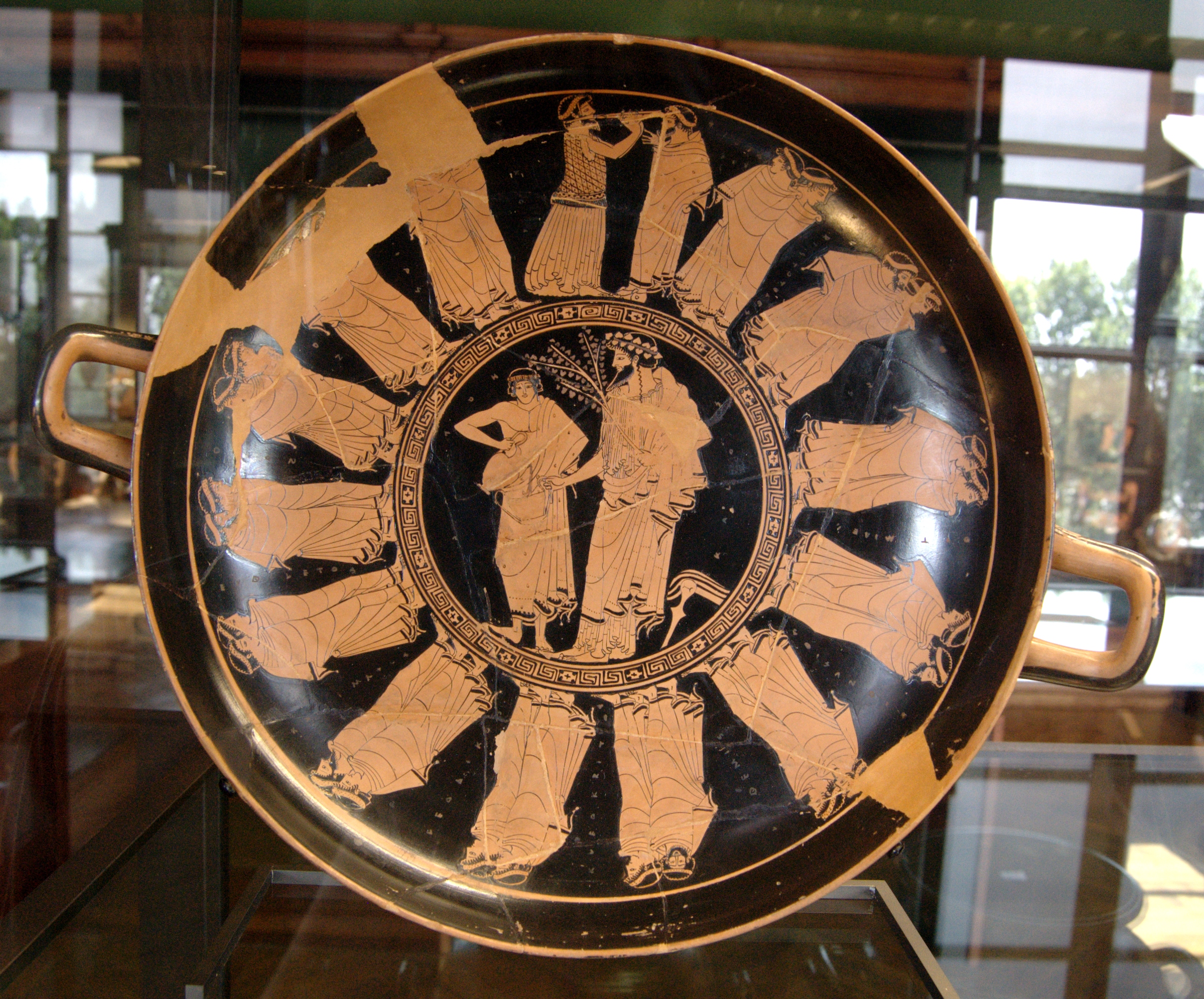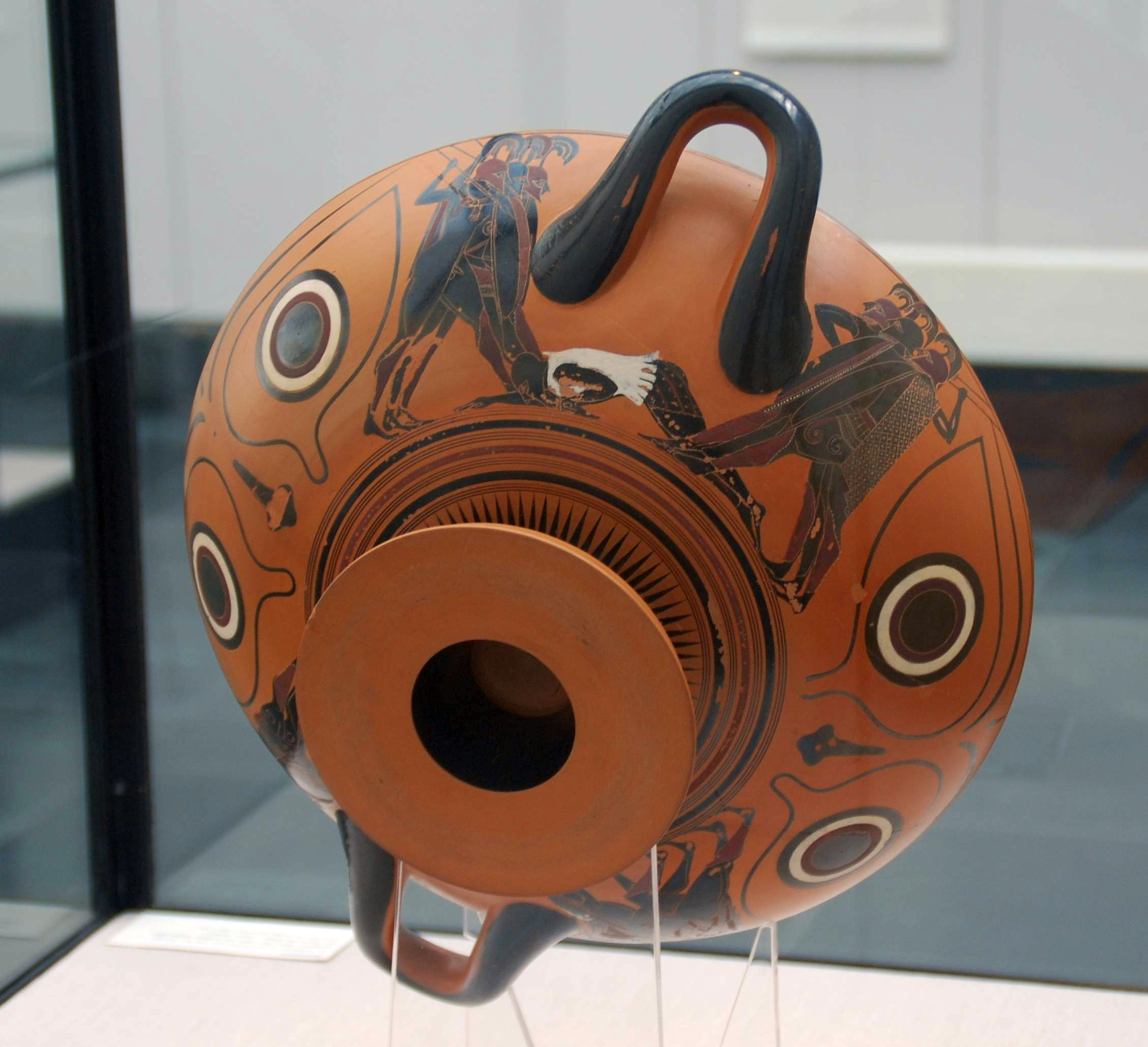|
Kylix
In the pottery of ancient Greece, a kylix ( , ; grc, κύλιξ, pl. κύλικες; also spelled cylix; pl.: kylikes , ) is the most common type of wine-drinking cup. It has a broad, relatively shallow, body raised on a stem from a foot and usually two horizontal handles disposed symmetrically. The main alternative wine-cup shape was the ''kantharos'', with a narrower and deeper cup and high vertical handles. The almost flat interior circle of the base of the cup, called the tondo, was generally the primary surface for painted decoration in the black-figure or red-figure pottery styles of the 6th and 5th century BC, and the outside was also often painted. As the representations would be covered with wine, the scenes would only be revealed in stages as the wine was drained. They were often designed with this in mind, with scenes created so that they would surprise or titillate the drinker as they were revealed. Etymology The word comes from the Greek ''kylix'' ("cup"), w ... [...More Info...] [...Related Items...] OR: [Wikipedia] [Google] [Baidu] |
Red-figure
Red-figure vase painting is one of the most important styles of figural Greek vase painting. It developed in Athens around 520 BCE and remained in use until the late 3rd century BCE. It replaced the previously dominant style of black-figure vase painting within a few decades. Its modern name is based on the figural depictions in red color on a black background, in contrast to the preceding black-figure style with black figures on a red background. The most important areas of production, apart from Attica, were in Southern Italy. The style was also adopted in other parts of Greece. Etruria became an important center of production outside the Greek World. Attic red-figure vases were exported throughout Greece and beyond. For a long time, they dominated the market for fine ceramics. Few centers of pottery production could compete with Athens in terms of innovation, quality and production capacity. Of the red-figure vases produced in Athens alone, more than 40,000 specimens and f ... [...More Info...] [...Related Items...] OR: [Wikipedia] [Google] [Baidu] |
Symposium
In ancient Greece, the symposium ( grc-gre, συμπόσιον ''symposion'' or ''symposio'', from συμπίνειν ''sympinein'', "to drink together") was a part of a banquet that took place after the meal, when drinking for pleasure was accompanied by music, dancing, recitals, or conversation.Peter Garnsey, ''Food and Society in Classical Antiquity'' (Cambridge University Press, 1999), p. 13online Sara Elise Phang, ''Roman Military Service: Ideologies of Discipline in the Late Republic and Early Principate'' (Cambridge University Press, 2008), pp. 263–264. Literary works that describe or take place at a symposium include two Socratic dialogues, Plato's '' Symposium'' and Xenophon's '' Symposium'', as well as a number of Greek poems such as the elegies of Theognis of Megara. Symposia are depicted in Greek and Etruscan art that shows similar scenes. In modern usage, it has come to mean an academic conference or meeting such as a scientific conference. The equivalent of a G ... [...More Info...] [...Related Items...] OR: [Wikipedia] [Google] [Baidu] |
Eye-cup
Eye-cup is the term describing a specific cup type in ancient Greek pottery, distinguished by pairs of eyes painted on the external surface. Description Classified as '' kylikes'' in terms of shape, eye-cups were especially widespread in Athens and Chalkis in the second half of the sixth century BC. The bowl of the eye-cup rests on a short squat foot; both sides are dominated by large painted pairs of eyes under arched eyebrows. The eyeballs are painted in silhouette style, later often filled with white paint or painted white on black. Some eyes are “female”, i.e. almond-shaped and without tear-ducts. Often, a stylized nose is placed centrally between the eyes. While used as a drinking vessel, due to the necessary inclination of the vessel, the cup with its painted eyes, the handles looking like ears and the base of the foot like a mouth, would have resembled a mask. Many of the vases also bear dionysiac imagery. The eyes are assumed to have served an apotropaic (evil- ... [...More Info...] [...Related Items...] OR: [Wikipedia] [Google] [Baidu] |
Pottery Of Ancient Greece
Ancient Greek pottery, due to its relative durability, comprises a large part of the archaeological record of ancient Greece, and since there is so much of it (over 100,000 painted vases are recorded in the Corpus vasorum antiquorum), it has exerted a disproportionately large influence on our understanding of Greek society. The shards of pots discarded or buried in the 1st millennium BC are still the best guide available to understand the customary life and mind of the ancient Greeks. There were several vessels produced locally for everyday and kitchen use, yet finer pottery from regions such as Attica was imported by other civilizations throughout the Mediterranean, such as the Etruscans in Italy.John H. Oakley (2012). "Greek Art and Architecture, Classical: Classical Greek Pottery," in Neil Asher Silberman et al. (eds), ''The Oxford Companion to Archaeology, Vol 1: Ache-Hoho'', Second Edition, 641–644. Oxford & New York: Oxford University Press. , p. 641. There were a mul ... [...More Info...] [...Related Items...] OR: [Wikipedia] [Google] [Baidu] |
Kottabos (game)
Kottabos ( grc, κότταβος) was a game of skill played at Ancient Greek and Etruscan symposia (drinking parties), especially in the 6th and 5th centuries BC. It involved flinging wine-lees (sediment) at a target in the middle of the room. The winner would receive a prize (κοττάβιον or "kottabion"), comprising cakes, sweetmeats, or kisses. Ancient writers, including Dionysius Chalcus, Alcaeus, Anacreon, Pindar, Bacchylides, Aeschylus, Sophocles, Euripides, Aristophanes, and Antiphanes, make frequent and familiar allusion to the practice; and it is depicted on contemporaneous red-figure vases. References to the practice by the writers of the Roman and Alexandrian periods show that the fashion had died out. In Latin literature it is almost entirely unknown. Dexterity was required to succeed in the game, and unusual ability was rated as highly as corresponding excellence in throwing the javelin. Kottabos was customary, and, at least in Sicily, special circula ... [...More Info...] [...Related Items...] OR: [Wikipedia] [Google] [Baidu] |
Tondo (art)
A tondo (plural "tondi" or "tondos") is a Renaissance term for a circular work of art, either a painting or a sculpture. The word derives from the Italian ''rotondo,'' "round." The term is usually not used in English for small round paintings, but only those over about 60 cm (two feet) in diameter, thus excluding many round portrait miniatures – for sculpture the threshold is rather lower. A circular or oval relief sculpture is also called a roundel. History Artists have created tondi since Greek antiquity. The circular paintings in the centre of painted vases of that period are known as tondi, and the inside of the broad low winecup called a '' kylix'' also lent itself to circular enframed compositions. The style was revived in the fifteenth and sixteenth centuries, particularly in Italy, where it may have developed from the smaller desco da parto or birthing tray. Since then it has been less common. In Ford Madox Brown's painting '' The Last of England'', the ... [...More Info...] [...Related Items...] OR: [Wikipedia] [Google] [Baidu] |
Hellenic Civilization
Ancient Greece ( el, Ἑλλάς, Hellás) was a northeastern Mediterranean civilization, existing from the Greek Dark Ages of the 12th–9th centuries BC to the end of classical antiquity ( AD 600), that comprised a loose collection of culturally and linguistically related city-states and other territories. Most of these regions were officially unified only once, for 13 years, under Alexander the Great's empire from 336 to 323 BC (though this excludes a number of Greek city-states free from Alexander's jurisdiction in the western Mediterranean, around the Black Sea, Cyprus, and Cyrenaica). In Western history, the era of classical antiquity was immediately followed by the Early Middle Ages and the Byzantine period. Roughly three centuries after the Late Bronze Age collapse of Mycenaean Greece, Greek urban poleis began to form in the 8th century BC, ushering in the Archaic period and the colonization of the Mediterranean Basin. This was followed by the age of Classical Greec ... [...More Info...] [...Related Items...] OR: [Wikipedia] [Google] [Baidu] |
Dionysos
In ancient Greek religion and Greek mythology, myth, Dionysus (; grc, wikt:Διόνυσος, Διόνυσος ) is the god of the grape-harvest, winemaking, orchards and fruit, vegetation, fertility, insanity, ritual madness, religious ecstasy, festivity, and theatre, theatre. The Ancient Rome, Romans called him Bacchus ( or ; grc, wikt:Βάκχος, Βάκχος ) for a frenzy he is said to induce called ''bakkheia''. As Dionysus Eleutherios ("the liberator"), his wine, music, and ecstatic dance free his followers from self-conscious fear and care, and subvert the oppressive restraints of the powerful. His ''thyrsus'', a fennel-stem sceptre, sometimes wound with ivy and dripping with honey, is both a beneficent wand and a weapon used to destroy those who oppose his cult and the freedoms he represents. Those who partake of his mysteries are believed to become possessed and empowered by the god himself. His origins are uncertain, and Cult of Dionysus, his cults took many forms ... [...More Info...] [...Related Items...] OR: [Wikipedia] [Google] [Baidu] |
Merrythought Cup
The term Merrythought cup is used by scholars to describe a specific type of Attic An attic (sometimes referred to as a ''loft'') is a space found directly below the pitched roof of a house or other building; an attic may also be called a ''sky parlor'' or a garret. Because attics fill the space between the ceiling of the ... '' kylix''. The Merrythought cup, named after the British word for "wishbone," probably developed as a refined form of a rural cup type normally made of wood. The shape features several peculiarities. It is the first Attic cup shape that lacks a distinctive break between lip and vessel body. The shape of the handles, which give the vessel its name, are in the oblong wishbone shape, with a knob shape on the curve of the handle. Rather than forming a semi-circle, as is the case in virtual all other cup shapes. Equally unusual, the handles extend beyond the height of the vessel body. The cups, mostly covered in black slip, occasionally feature thin stripe ... [...More Info...] [...Related Items...] OR: [Wikipedia] [Google] [Baidu] |
Black-figure
Black-figure pottery painting, also known as the black-figure style or black-figure ceramic ( grc, , }), is one of the styles of painting on antique Greek vases. It was especially common between the 7th and 5th centuries BCE, although there are specimens dating as late as the 2nd century BCE. Stylistically it can be distinguished from the preceding orientalizing period and the subsequent red-figure pottery style. Figures and ornaments were painted on the body of the vessel using shapes and colors reminiscent of silhouettes. Delicate contours were incised into the paint before firing, and details could be reinforced and highlighted with opaque colors, usually white and red. The principal centers for this style were initially the commercial hub Corinth, and later Athens. Other important production sites are known to have been in Laconia, Boeotia, eastern Greece, and Italy. Particularly in Italy individual styles developed which were at least in part intended for the Etrusca ... [...More Info...] [...Related Items...] OR: [Wikipedia] [Google] [Baidu] |
.jpg)






.jpg)

